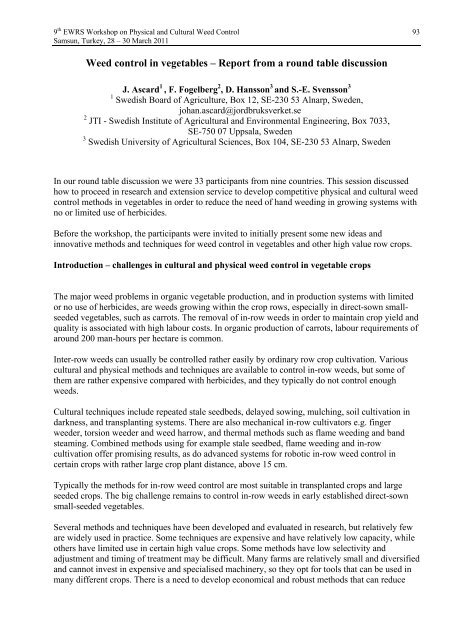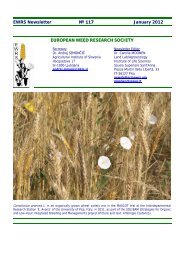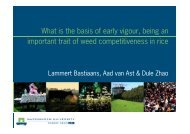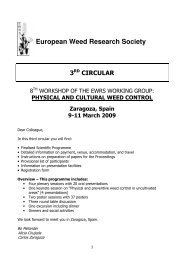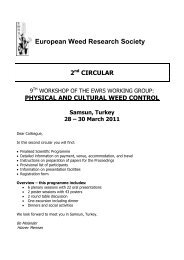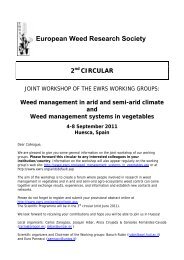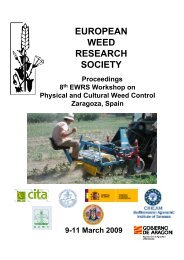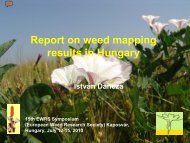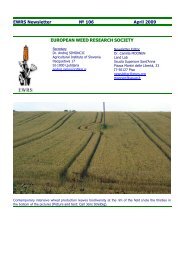Physical and Cultural Weed Control Working Group of - European ...
Physical and Cultural Weed Control Working Group of - European ...
Physical and Cultural Weed Control Working Group of - European ...
Create successful ePaper yourself
Turn your PDF publications into a flip-book with our unique Google optimized e-Paper software.
9 th EWRS Workshop on <strong>Physical</strong> <strong>and</strong> <strong>Cultural</strong> <strong>Weed</strong> <strong>Control</strong> 93<br />
Samsun, Turkey, 28 – 30 March 2011<br />
<strong>Weed</strong> control in vegetables – Report from a round table discussion<br />
J. Ascard 1 , F. Fogelberg 2 , D. Hansson 3 <strong>and</strong> S.-E. Svensson 3<br />
1 Swedish Board <strong>of</strong> Agriculture, Box 12, SE-230 53 Alnarp, Sweden,<br />
johan.ascard@jordbruksverket.se<br />
2 JTI - Swedish Institute <strong>of</strong> Agricultural <strong>and</strong> Environmental Engineering, Box 7033,<br />
SE-750 07 Uppsala, Sweden<br />
3 Swedish University <strong>of</strong> Agricultural Sciences, Box 104, SE-230 53 Alnarp, Sweden<br />
In our round table discussion we were 33 participants from nine countries. This session discussed<br />
how to proceed in research <strong>and</strong> extension service to develop competitive physical <strong>and</strong> cultural weed<br />
control methods in vegetables in order to reduce the need <strong>of</strong> h<strong>and</strong> weeding in growing systems with<br />
no or limited use <strong>of</strong> herbicides.<br />
Before the workshop, the participants were invited to initially present some new ideas <strong>and</strong><br />
innovative methods <strong>and</strong> techniques for weed control in vegetables <strong>and</strong> other high value row crops.<br />
Introduction – challenges in cultural <strong>and</strong> physical weed control in vegetable crops<br />
The major weed problems in organic vegetable production, <strong>and</strong> in production systems with limited<br />
or no use <strong>of</strong> herbicides, are weeds growing within the crop rows, especially in direct-sown smallseeded<br />
vegetables, such as carrots. The removal <strong>of</strong> in-row weeds in order to maintain crop yield <strong>and</strong><br />
quality is associated with high labour costs. In organic production <strong>of</strong> carrots, labour requirements <strong>of</strong><br />
around 200 man-hours per hectare is common.<br />
Inter-row weeds can usually be controlled rather easily by ordinary row crop cultivation. Various<br />
cultural <strong>and</strong> physical methods <strong>and</strong> techniques are available to control in-row weeds, but some <strong>of</strong><br />
them are rather expensive compared with herbicides, <strong>and</strong> they typically do not control enough<br />
weeds.<br />
<strong>Cultural</strong> techniques include repeated stale seedbeds, delayed sowing, mulching, soil cultivation in<br />
darkness, <strong>and</strong> transplanting systems. There are also mechanical in-row cultivators e.g. finger<br />
weeder, torsion weeder <strong>and</strong> weed harrow, <strong>and</strong> thermal methods such as flame weeding <strong>and</strong> b<strong>and</strong><br />
steaming. Combined methods using for example stale seedbed, flame weeding <strong>and</strong> in-row<br />
cultivation <strong>of</strong>fer promising results, as do advanced systems for robotic in-row weed control in<br />
certain crops with rather large crop plant distance, above 15 cm.<br />
Typically the methods for in-row weed control are most suitable in transplanted crops <strong>and</strong> large<br />
seeded crops. The big challenge remains to control in-row weeds in early established direct-sown<br />
small-seeded vegetables.<br />
Several methods <strong>and</strong> techniques have been developed <strong>and</strong> evaluated in research, but relatively few<br />
are widely used in practice. Some techniques are expensive <strong>and</strong> have relatively low capacity, while<br />
others have limited use in certain high value crops. Some methods have low selectivity <strong>and</strong><br />
adjustment <strong>and</strong> timing <strong>of</strong> treatment may be difficult. Many farms are relatively small <strong>and</strong> diversified<br />
<strong>and</strong> cannot invest in expensive <strong>and</strong> specialised machinery, so they opt for tools that can be used in<br />
many different crops. There is a need to develop economical <strong>and</strong> robust methods that can reduce


